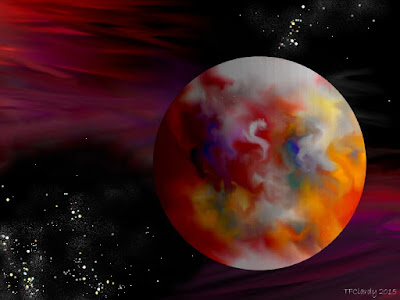Life of other worlds: drawings and sketches from one space explorer's travel journal is a series focusing on various other star systems in the Milky Way Galaxy.
The Aten-Ra System is a blue star system with
five planets, located near the Giza Nebula. Astronomer Dr. Piers Langland, a
member of the Unified Interplanetary Exploration Taskforce (UIET), discovered
the system and its neighboring nebula. The system received its name due to the fact that it was discovered the year that the
Forgotten Tombs were found and unearthed in Egypt. Sadly, it was also the year of the Bombing of the Great Pyramids
of Giza by religious fundamentalists.
The International Astronomical Union approved the naming of the system
after ancient Egyptian deities and the naming of the nebula after the Great Pyramids as a remembrance of the great events of that
year.
 |
Amun and its moon Isis
|
Amun
Many incredible life forms live in the thin
stable habitable zone on a gas giant. The food chain of the planet includes
large balloon-like carnivores, such as the Cloud Tiger, who consume the smaller
and plentiful Kites. Kites themselves consume spores from the many forms of
fungus and algae present in the zone.
 |
| Kites |
Cloud Tiger (genus
Aethercetus) captures Kites in a basket it swings through the air. The basket
contracts tightly around the Kites and then digests them. The creature floats
freely through the habitable zone of the gas giant, regulating its buoyancy to
keep itself at the correct altitude. The "tiger" stripes are thought
to resemble swarms of Kites causing other Kites to fly toward the Cloud Tiger,
thus luring them to their death as lunch for the great floating beast.
 |
| Cloud Tiger |
There was this creature we called
Macy (after the large balloon figures in the Macy's parade). We believed it to
be a member of the genus Aethercetus; if so, it is the largest member. It
trawled for food with a large "basket" at the bottom. The
"bubbles" on the side were young.
There was a carnivorous creature (genus
Aethercetus) analogous to the Orcas on Earth. It hunted other members of
the Aethercetus genus. We called it the Sky Orca. It seemed to prefer to eat
Cloud Tigers. It used the sharp pendulum to ram the Cloud Tigers and deflate
them; then released a dissolving agent to melt certain nutritious parts of its
prey, which it sucked up through a tube.
It did this very quickly as it slowly descended due to the extra
weight. Before reaching the point of no
return, it jettisoned the carcass of the Cloud Tiger and floated slowly up to a
higher altitude.
 |
| Sky Orca |
 |
| Creature we called Macy (after the large balloon figures in the Macy's parade) |
Sokar
 |
| Sokar and the Giza Nebula |
The Giza Nebula
Residing near the Aten-Ra System, the nebula fills the night skies of all the planets of the system. A defining feature of the nebula is its bright monochromatic redness, caused by the abundance of hydrogen. The three bright white dwarfs ( each one named after one of the three pyramids in Giza) are the three brightest points in the nebula. Some believe the vivid red-purple colour of Sokar is due to the capture of nebula hydrogen by the planet. An odd section of the Giza Nebula is separated from the main body and has a bright blue-white cast (see Hathor photo). Scientists believe that the high temperature of this region is caused by the fact that the hydrogen is being consumed in some unknown type of reaction. Some believe that the reaction might someday consume the entire nebula; others believe that it is a localized reaction. It has been put forth by some that the proximity of the "Blue Cloud" to the planetary system invites the question that the reaction is caused by abandoned alien technology. The establishment of a permanent space station (Langland Station UIET) in orbit around Hathor will study the Giza Nebula and its relationship with the Aten-Ra System.
Next in the series : The Sulis Star System

















No comments:
Post a Comment
Tell me what you think (But please do it nicely)